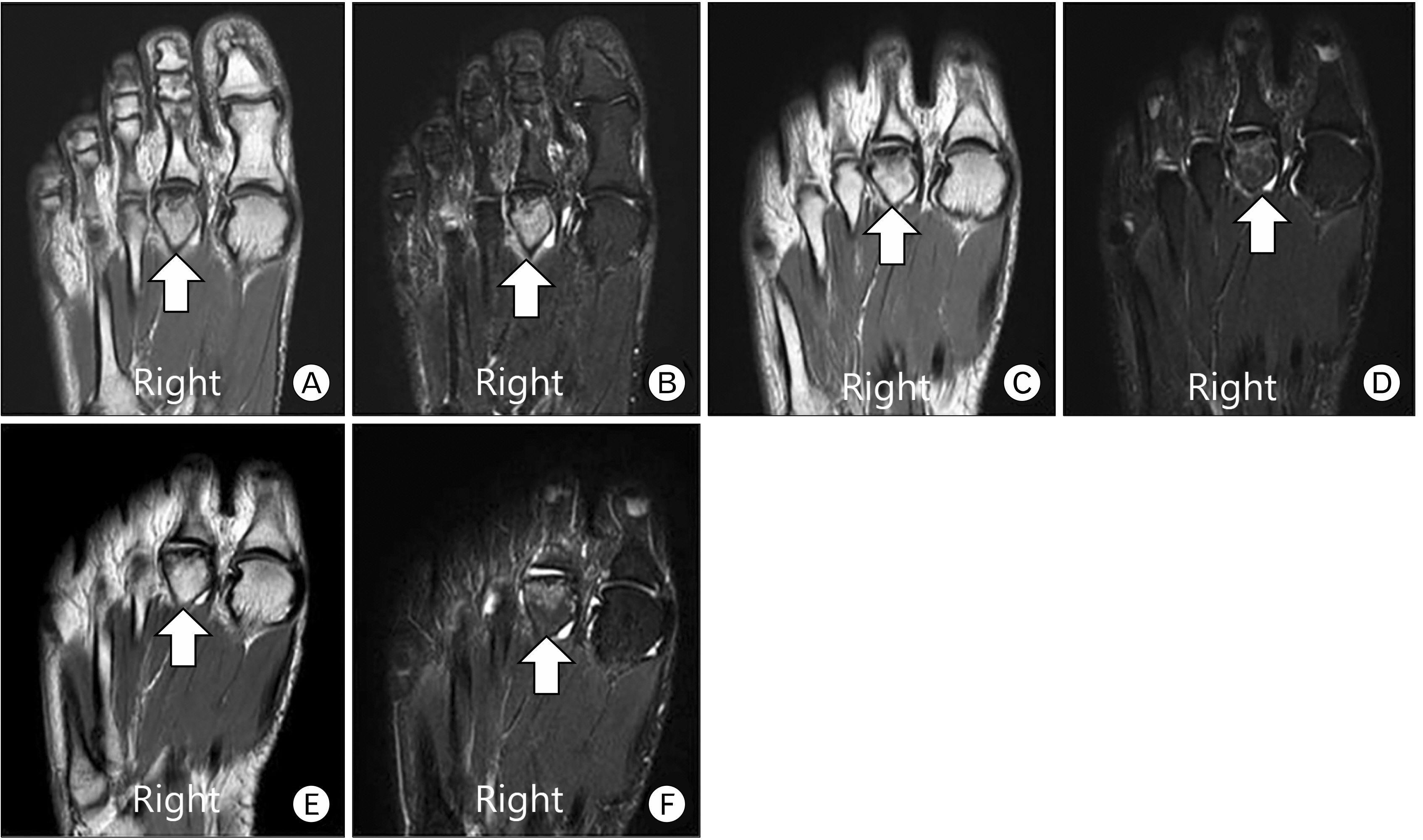Korean J Sports Med.
2023 Mar;41(1):45-49. 10.5763/kjsm.2023.41.1.45.
Conservative Management of Freiberg Disease with Shoe Modification and Insole: A Case Report with 2-Year Follow-up
- Affiliations
-
- 1Department of Physical and Rehabilitation Medicine, Kangbuk Samsung Hospital, Sungkyunkwan University School of M edicine, Seoul, Korea
- KMID: 2539689
- DOI: http://doi.org/10.5763/kjsm.2023.41.1.45
Abstract
- Freiberg disease, known as a Freiberg infraction, is an uncommon disorder of the second metatarsal head of the foot. Conservative treatment is recommended as initial management to relieve symptoms and minimize epiphyseal deformity. However, due to the rarity of this disorder, there have been few reports of long-term clinical and radiologic follow-ups of Freiberg disease treated with conservative treatment. We report Freiberg disease treated with conservative management including modification of shoe and insole. A 24-year-old woman presented with right forefoot pain. In plain radiography, the sunken appearance of the metatarsal head and periarticular spurring was observed. The articular cartilage was intact in magnetic resonance imaging (MRI), corresponding to Smillie’s stage 3 and Thompson’s type 2. We prescribed carbon fiber insert, customed semirigid insole with metatarsal dome and rocker-bottom shoe to relieve pressure under the metatarsal heads. Freiberg disease maintained a well-tolerable condition during 2-year follow-up period without further progression in MRI.
Keyword
Figure
Reference
-
1. Cerrato RA. 2011; Freiberg's disease. Foot Ankle Clin. 16:647–58. DOI: 10.1016/j.fcl.2011.08.008. PMID: 22118235.2. Wax A, Leland R. 2019; Freiberg disease and avascular necrosis of the metatarsal heads. Foot Ankle Clin. 24:69–82. DOI: 10.1016/j.fcl.2018.11.003. PMID: 30685014.3. Carmont MR, Rees RJ, Blundell CM. 2009; Current concepts review: Freiberg's disease. Foot Ankle Int. 30:167–76. DOI: 10.3113/FAI-2009-0167. PMID: 19254514.4. Seybold JD, Zide JR. 2018; Treatment of Freiberg disease. Foot Ankle Clin. 23:157–69. DOI: 10.1016/j.fcl.2017.09.011. PMID: 29362030.5. Talusan PG, Diaz-Collado PJ, Reach JS Jr. 2014; Freiberg's infraction: diagnosis and treatment. Foot Ankle Spec. 7:52–6. DOI: 10.1177/1938640013510314. PMID: 24319044.6. Shane A, Reeves C, Wobst G, Thurston P. 2013; Second metatarsophalangeal joint pathology and freiberg disease. Clin Podiatr Med Surg. 30:313–25. DOI: 10.1016/j.cpm.2013.04.009. PMID: 23827490.7. Smillie IS. 1967; Treatment of Freiberg's infraction. Proc R Soc Med. 60:29–31. DOI: 10.1177/003591576706000117. PMID: 5335092. PMCID: PMC1901414.8. Thompson FM, Hamilton WG. 1987; Problems of the second metatarsophalangeal joint. Orthopedics. 10:83–9. DOI: 10.3928/0147-7447-19870101-15. PMID: 3809019.9. Helal B, Gibb P. 1987; Freiberg's disease: a suggested pattern of management. Foot Ankle. 8:94–102. DOI: 10.1177/107110078700800205. PMID: 3679029.10. Sproul J, Klaaren H, Mannarino F. 1993; Surgical treatment of Freiberg's infraction in athletes. Am J Sports Med. 21:381–4. DOI: 10.1177/036354659302100309. PMID: 8346751.
- Full Text Links
- Actions
-
Cited
- CITED
-
- Close
- Share
- Similar articles
-
- Shoe and Insole Modification for Hallux Valgus and Its Associated Foot Deformities
- Autogenous Osteochondral Graft for Freiberg's Disease: A Case Report
- A Study on the Therapeutic Shoes for Diabetic Patients
- Freiberg's Disease and Metatarsophalangeal Joint Instability
- Dorsal Closing Wedge Osteotomy in Freiberg's Disease




